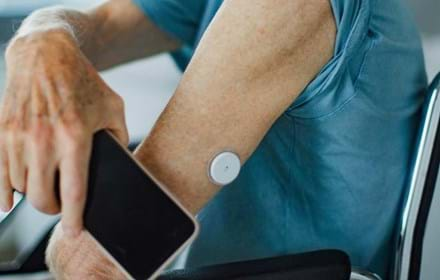
Singing the praises of insulin pumps – and asking why so few people with type 1 diabetes are receiving access to this life-changing technology
DRWF Research Manager Dr Eleanor Kennedy with the final instalment of her blog reports from Day Ten of the Diabetes UK Professional Conference.
And then, as if by magic, we are whisked two weeks forward and entering the tenth and final day of the Diabetes UK Professional Conference for 2021. It begins with the Janet Kinson Lecture, this year given by Dr Emma Willmott talking about Living with type 1 diabetes: What really matters?
Dr Willmott (also featured in the blog from Day Three) began by explaining who Janet Kinson was – a nurse, innovator, and educator with a remarkable commitment to diabetes education. She developed the first training programme for nurses working in diabetes and her enthusiasm and commitment to diabetes care – particularly person-centred diabetes care – has motivated many others.
Dr Willmott then returns “to the matter in hand today,” as she says – the reality of living with type 1 diabetes. Planning exercise. Worry about hypos. Reviewing data. Planning food. Counting carbs. Calculating insulin doses. Checking glucose. Competing stresses. Thinking ahead. It is all “…absolutely relentless”.
With the recognition that diabetes is really tough, healthcare professionals must be seeking person-centred solutions and finding novel ways to improve outcomes without adding to the burden.
Why do healthcare professionals strive for lower HbA1c and improved cardiometabolic health in people with diabetes?
To avoid complications? Of course. However, Dr Willmott suggested that just because they have a negative impact on quality of life, this can, in turn, be putting such a huge demand on the person with diabetes that it negatively impacts on their quality of life so we may perhaps be missing the point.
To enable better outcomes in type 1 diabetes, Dr Willmott proposed a three-fold way of exploring this – diabetes technology including insulin pump therapy, interstitial glucose monitoring and closed loop therapy; education through structured education for people with diabetes; and upskilling of healthcare professionals and support, for both peers and healthcare professionals.
Discussing the DAFNE structured education programme in some depth, Dr Willmott showed that, after 20 years in existence and more than 50,000 graduates later, there is ample evidence to demonstrate that it leads to an improvement in HbA1c, treatment satisfaction, wellbeing and quality of life. There is also a reduced prevalence of severe hypoglycaemia (low blood glucose levels).

The benefits of using an insulin pump – why the slow uptake?
Shifting to diabetes technology, Dr Willmott sang the praises of insulin pumps which remove the need for multiple daily injections, are easy to bolus and have an inbuilt bolus calculator can improve glucose levels and lead to less hypoglycaemia. However, despite this, research figures show that the UK is lagging behind its European counterparts when it comes to uptake.
In 2018, uptake was about 18% in adults with Denmark on 21% and Sweden on 24%. When the total figures are looked at for adults and young people under the age of 18, uptake in the USA stands at 63% dwarfing the corresponding figure in the UK. More worryingly is the discrepancy with uptake among individual centres in England and Wales with some as high as 40%, while other areas languish around 5%.
However, when it comes to flash glucose monitoring, there is substantial uptake - 36% in January 2021 compared to just 10.7% in April 2019 representing perhaps one of the most rapid uptakes of a technology in type 1 diabetes that has ever been seen. The data from users demonstrate about a 5mmol/mol reduction in HbA1c, a reduced number of hospital admissions and severe hypoglycaemia and lower levels of diabetes-related distress.
Importance peer support and setting up support networks
Finally, Dr Willmott moves onto support, with particular emphasis on peer support and stressing how easy such a support group is to set up. “All it takes is a couple of interested individuals to set up the group!” The local healthcare team will then simply point out the existence of this self-regulating group to others diagnosed with diabetes. Dr Willmott concluded with the thought-provoking question “What life changing interventions are you able to offer the next person in your clinic?”
In the final session of the day for me and, indeed, for the conference is another session focussed on type 1 diabetes - SGLT2 inhibitors: A cardiac, renal and type 1 diabetes perspective.
Starting with the cardiologist’s viewpoint of this new – and increasingly popular - class of drugs. Citing the EMPA-REG cardiovascular outcome trial, he talked about how this study demonstrated that a drug for type 2 diabetes reduced cardiovascular death by around one-third as well as reducing hospitalisation for heart failure by, again, about one-third.
These outcomes mimicked in other trials like the CANVAS Program, VERTIS-CV and DECLARE-TIMI 58 make the SGLT-2 inhibitors a really good class of drug for cardiologists to use. He concluded by saying that, in a study of almost 60,000 people with type 2 diabetes, over the course of one year, people with type 2 diabetes were 2.6 times more likely to have an outpatient encounter with a cardiologist than with an endocrinologist giving cardiologists a unique opportunity to improve outcomes in their patients with type 2 diabetes.
Treatment options for people with diabetes-related kidney disease
Next up is the nephrologist’s viewpoint on SGLT-2 inhibitors. Kidney disease in the context of diabetes is posing an increasing challenge to the healthcare community let along the individuals who are affected by this complication. Currently, management strategies to prevent or slow down the development of diabetes-related kidney disease (DKD) are suboptimal. SGLT-2 inhibitors have demonstrated significant benefit in relation to an amelioration of DKD and the evidence had confirmed that they should be considered as a routine treatment for individuals with diabetes and evidence of DKD, irrespective of glycaemic effectiveness.
The glycaemic efficacy of SGLT-2 inhibitors is dependent on kidney function and efficiency is reduced in patients with an estimated glomerular filtration rate (eGFR) of less than 60 and are unlikely to have any glycaemic lowering effect at an eGFR of less that 30.
Finally, the viewpoint of the diabetologist who showed data to support that SGLT-2 inhibitors in type 1 diabetes led to modest improvements in HbA1c at 52 weeks. Non-glycaemic benefits include weight loss, reduction in blood pressure and reduced albumin excretion rates. However, their use does include risks like an increase in the incidence of acidosis-related adverse events and genital mycotic events. Patient selection and, importantly, education about early identification and managing ketoacidosis is essential. And further research is needed to understand the cardiovascular and renal benefits of SGLT-2 inhibitors in type 1 diabetes as the totality of effects of this class of drug probably does deserves a place in the management of type 1 diabetes.
With that, class is dismissed!
The longest diabetes conference in living memory is over!
In the very first blog from Day One of this conference, I opined that I felt saddened that I “never fully appreciated the brilliant feeling that is packing up and heading off to a conference where I will learn something new every minute of every day and where I will meet familiar faces to share a coffee or a glass of wine with”.
Trust me on this one… when we are finally allowed to travel again and the conference organisers feel confident in holding face-to-face events again, I will never take that wonderful feeling of seeing and listening to people in the flesh for granted again!
Further reports to follow – visit DRWF news page
Follow Dr Eleanor Kennedy on Twitter: @DRWFEleanor
Support DRWF by making a donation here
Find out more about DRWF-funded research here
Find out more about DRWF fundraising here
For latest update follow DRWF on Facebook, Instagram and Twitter
To receive the charity’s latest bulletins as they become available, please sign up here
Read DRWF diabetes information leaflets here
Join the Diabetes Wellness Network here
Recent News


